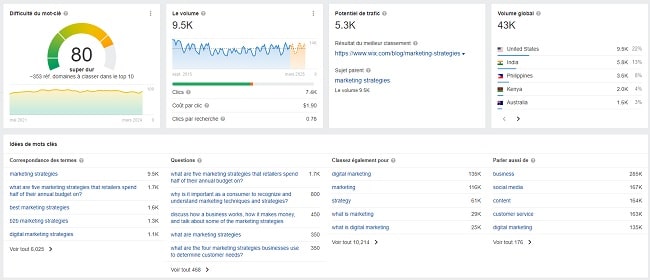Keyword Strategy: The Recipe for Success
Baobabteam is an international blog dedicated to marketing, sales techniques, and communication. With the #RoadTo100k project, our goal is to reach 100,000 visitors per month within a year. To achieve this, we have implemented an in-depth keyword strategy based on several steps.
First, we used the Ahrefs tool to identify the most relevant terms in our sector.
High-volume generic keywords like “marketing strategy” (140,000 searches/month) helped define the main categories of the site. For each category, we write a 2,000-word reference article optimized for the target keyword.
With Ahrefs, we also generate variants (e.g., “mobile marketing strategy”) that become dedicated articles.
This strategy will multiply our content in English and other languages.
1. The Importance of Keywords in Search Engine Optimization (SEO)
Keywords are crucial for search engine optimization and website visibility. They allow search engines like Google to understand the topic of a page and determine if it matches users’ queries.
The more a web content contains relevant keywords used in the right proportions, the more likely it is to appear in good position on the search results pages. That’s why identifying the right key terms and expressions related to your business is essential when optimizing for SEO.
An in-depth analysis of keywords, their search volume, and competition, as Baobabteam did with Ahrefs, is the starting point for an effective SEO strategy. It will enable the creation of optimized content that perfectly meets users’ needs.
2. Using Ahrefs to Identify Relevant Keywords
Ahrefs is a powerful SEO analysis tool that allows in-depth exploration of potentially interesting keywords for a website.
Thanks to its database of billions of pages, Ahrefs also suggested numerous other relevant keywords related to our topics, classified according to different criteria: monthly search volume, competition for these terms, trends, difficulty in obtaining top positions, etc.
By combining our editorial expertise and data provided by Ahrefs, we selected the most promising key expressions for our business. This selection is the cornerstone of our content strategy.

3. Defining Site Categories and Main Keywords
From the generic keywords identified with Ahrefs, we defined the main content categories of our site: digital marketing, natural referencing (SEO), sales, surveys, etc.
For each category, we selected the most relevant and promising keyword. For example, for the SEO section, our main term is “search engine optimization.” This keyword gets 117,000 monthly searches.
These main keywords define the site’s structure and the topics covered. They are the subject of in-depth 2,000-word blog posts, specifically written to address users’ intentions. The goal is to become an essential reference on each of these key subjects.
This precise definition of categories upfront allows us to build an entire coherent and interconnected content ecosystem around these strong axes. It lays the foundations for our data-driven editorial strategy.
4. Writing Reference Articles for Each Main Keyword
For each identified main keyword, we write a minimum 2,000-word reference blog post.
The objective is to cover the subject in-depth from all angles, to become THE essential resource on that topic.
We structure these editorial pieces by introducing the subject, detailing key points and concepts, providing concrete examples and case studies, as well as a conclusion with perspectives on the field.
These pillar articles contain all the relevant secondary keywords on the subject to address its various facets. They are written in an expert and didactic style, with internal links pointing to other complementary articles.
With these high-quality, user intent-focused contents, we aim for the top 3 search engine results for our target keywords, synonymous with traffic.
5. Developing Term Matches to Diversify Articles
From each main keyword, we again use the Ahrefs tool to generate ideas for related terms and relevant variants.
For example, for our “Marketing Strategy” category, in addition to the generic term, Ahrefs suggests targeted matches like “B2B marketing strategy,” “startup marketing strategy,” “content marketing strategy,” etc.
We select the most interesting variants and write a dedicated article for each one, specifically optimizing it around that key phrase.
The goal is to multiply content and angles on our core “marketing strategy” theme, to reach all types of searches and intentions related to that subject.
In total, more than 100 articles will be created around our main keyword “marketing strategy” and its variations. This lexical diversification is key to broadening our audience and visibility.
6. Creating Links Between Articles to Reinforce Site Authority
To consolidate our site’s authority and the positioning of our pages on certain keywords, we integrate numerous internal links between our articles.
The goal is to structure our content around our main themes and reinforce the internal linking of the site. For example, in all our marketing-related articles, we link to our “marketing strategy” pillar optimized for that term.
These relevant internal links related to the topic improve the user experience by allowing fluid navigation between our related contents. They also signal to search engines that we are a legitimate authority on these subjects.
Thanks to this interconnection of our editorial ecosystem through internal links, we gain authority on our target keywords. In the long run, this will boost our visibility on the internet.
7. Respecting the Keyword Percentage in Content
When writing our optimized articles, we ensure to respect the recommended keyword percentage to avoid overloading our content. Indeed, an excessive presence of keywords can harm search engine optimization and give a spammy impression.
The ideal keyword density is between 1% and 3%. We base ourselves on these figures to harmoniously distribute our target terms in our content while writing naturally for users.
Thus, a 2,000-word article will contain between 20 and 60 occurrences of the targeted keyword. We use the Yoast SEO tool to ensure we are within these ranges and that the term distribution is optimal.
With this balanced approach, we produce informative articles that meet readers’ needs while remaining perfectly optimized for natural referencing.
Outlook for Baobabteam’s Keyword Strategy
Our goal remains to reach 100,000 monthly visitors within a year. It seems within our reach thanks to the solid foundations of our SEO strategy based on keywords.
The next step in our journey will be to buy links to boost the rankings of our articles… stay tuned!
More about marketing:
BaobabTeam Blog Goes Global: Our Plan, click here
Why Colormag Pro? Our Blog’s Bold Move, click here
BaobabTeam Goes Social: Aiming for 100K, click here
On the Fast Track: Acquiring a Top Domain, click here
Baobab Inspired Branding: Rooted in Strategy, click here
AI-Powered Content: Growing BaobabTeam Fast, click here


